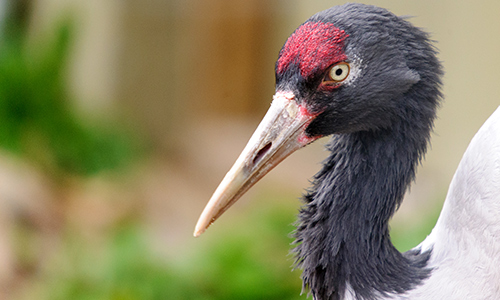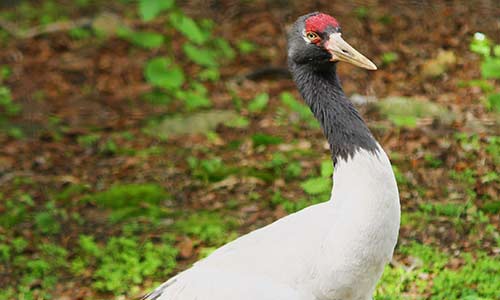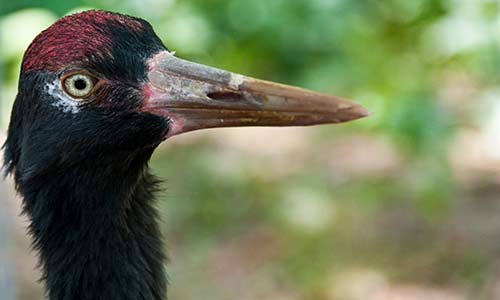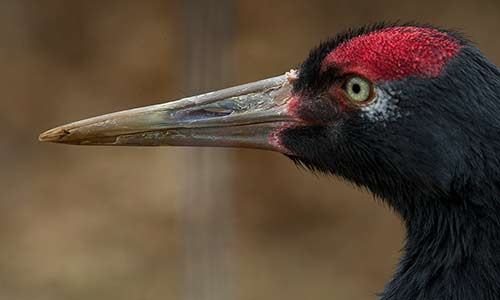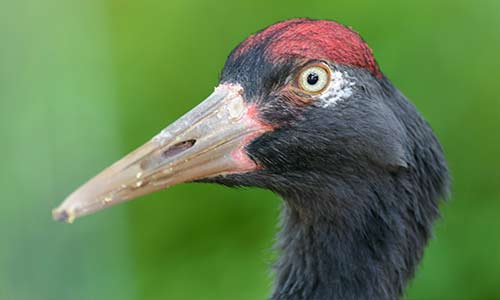Black-Necked Crane
Grus nigricollis
About the Black-Necked Crane

Geographic Range:
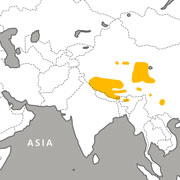
Class: Aves
Order: Gruiformes
Family: Gruidae
Genus: Grus
Species: nigricollis
As its name implies, the black-necked crane’s head, throat and entire neck is black. The crane has a white patch beneath the eye, a red crown and white body plumage. This large, wading bird can outrun a human and is a good swimmer despite its lack of webbed feet. Its native range is in South Asia, where these birds have long been held in high regard by Asian cultures and often appear in regional artwork.
Black-Necked Crane Facts
Appearance:
The black-necked crane is a large, wading bird with long legs and neck. As its name implies, the head, throat and entire neck of the crane is black. They have a white patch beneath the eye and a red crown atop their head. Tertiary wing and tail feathers are black, while the rest of the body plumage is white.
Size:
- Height: 4 feet
- Weight: 12 pounds
- Wingspan: Approximately 7 to 8 feet
Behavior:
Black-necked cranes are such fast runners that they could even outrun a human. Despite their lack of webbed feet, they are excellent swimmers. They can often be found bathing in water or in dust. While preening, black-necked cranes apply oil from a gland at the base of the tail to condition their feathers.
Black-necked cranes communicate with vocalizations and postures. They can be aggressive and will attempt threat postures to avoid fighting. When fighting does break out, the birds leap in the air trying to strike opponents with their sharp claws or beak.
Reproduction:
Black-necked cranes breed between March and May and incubate their eggs for 30-33 days, nesting in high altitude freshwater wetlands. Nests are built on small, grassy islands or in the water, consisting of mud, grass, and other aquatic plants. Typically, a female will lay two eggs, and those offspring will fledge after about 90 days. Male cranes take the primary role of defending the nest against predators. Cranes reach sexual maturity at 2-3 years of age.
Range:
Breeding occurs on the plateaus of Tibet, in northeastern India and northwest China. They spend winter in lower altitudes of southeast China and northern Vietnam. The range of this species was unknown to the western world until the 1970’s.
Diet:
Black-necked cranes are omnivorous, and they enjoy eating plant roots, tubers, snails, shrimp, and other small vertebrates and invertebrates.
Median Life Expectancy:
Up to 30 years
Fun Facts:
- The black-necked crane is the only alpine member of the crane species.
- They have long been held in high regard by Asian cultures and are often seen in artwork.
- They were the last species of crane discovered and described by ornithologists due to the remoteness of their range.
You Can Find This Animal in the Alfred Huang North American Crane Habitat
You might also like
At Franklin Park Zoo:
At Stone Zoo:

